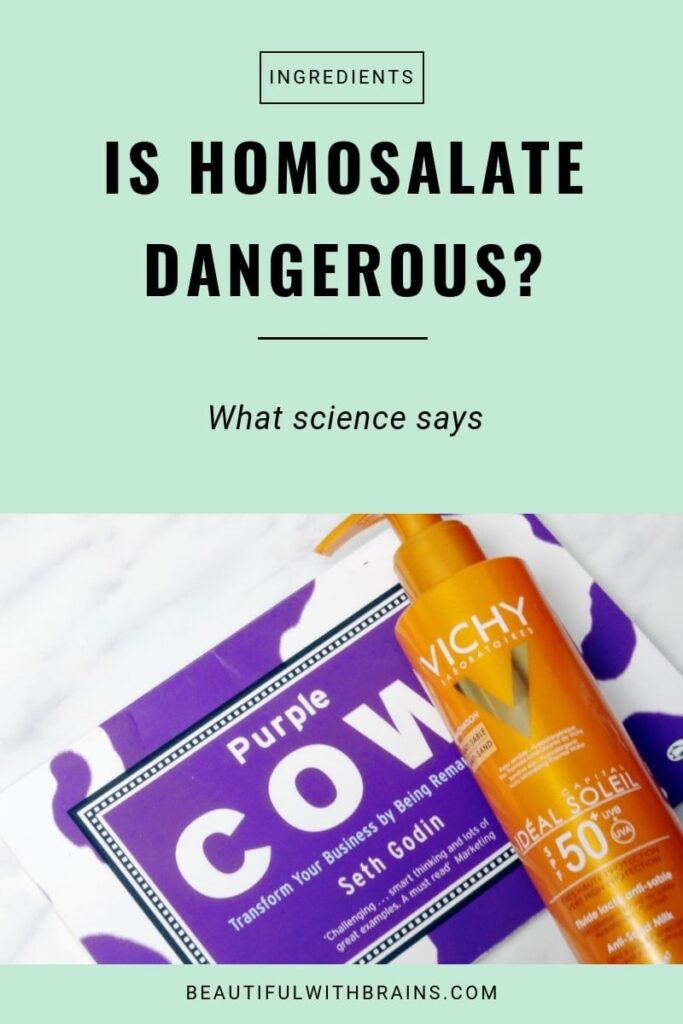Artificial UV filters like firm. Mineral sunscreens usually use solely ONE UV filter to maintain your pores and skin secure from UV hurt, however chemical sunscreens want far more than that. They usually go for a combo of 4 or 5. Why is that?
As a result of a single artificial filter hardly ever cuts it-each one solely covers a slice of the UV spectrum. You want that group of filters working collectively to cowl each UVA and UVB rays. In any other case, you’d get patchy safety at greatest. Some filters are higher at absorbing UVB (the burning rays), whereas others are stronger towards UVA (the getting old rays). So formulators combine and match to create a well-rounded protect.
An instance of a weak artificial filter that wants firm? Homosalate. It’s not probably the most well-known UV filter – most likely as a result of it barely works by itself. However, as most artificial UV filters are ending up underneath scrutiny for probably not being the most secure possibility, some individuals at the moment are questioning: is Homosalata harmful? Let’s discover out:
What Is Homosalate And What Does It Do?
Homosalate is a salycilate (a by-product of salicylic acid). Like all salycilates, it’s a weak UVB absorber for 2 causes. One: it solely gives SFP 4 at 10% concentrations (and, by regulation, you may’t use it at a better focus than 15%). In different worse, it struggles to guard pores and skin properly from UVB rays (it has a SPF of simply 4 at a focus of 10%).
And two: that little safety is just from UVB rays. Homoslate provides NO safety from UVA rays in any respect. Utilizing it alone can be loopy. You could pair with Avonbenzone or different filters that may end the job and provides the method broad spectrum safety.
In the event you’re questioning the way it works, homoslate absorbs UVB rays and transforms them right into a much less harmful type of power (warmth). That’s mainly the principle gig of most chemical filters: they take in UV rays and spit them out as warmth, which your pores and skin can deal with
Associated: Is Avobenzone In Sunscreens Safe?
Is your sunscreen as much as the job? Obtain your FREE “Sunscreen Audit” cheatsheet to seek out out in case your sunscreen is each efficient AND secure:
Does Homosolate Degrade Rapidly?
One more reason why homosalate is a weak UV absorber? It degrades rapidly when uncovered to daylight. That’s catch 22 with UV filters. You want them to guard you from from the solar. However daylight deactivates them. The stronger the solar’s rays are and the longer you keep within the solar, the earlier UV filters cease working. That’s why you need to reapply sunscreen every two hours. Ironic, isn’t it?
And it’s not simply homosalate-other filters like avobenzone and oxybenzone have the identical downside. They’re sort of fragile in terms of solar publicity. That’s why formulators usually throw stabilizers or different filters into the combination to decelerate that breakdown. It’s like including reinforcements to your sunscreen military.
Associated: How To Reapply Sunscreen While Wearing Makeup
Is Homosalate Harmful?
Now, the query you all need to ask: is homosalate harmful? Just about each different artificial UV filter is accused (usually wrongly) of inflicting most cancers or another nasty illness, so it’s solely pure to imagine that overzealous people might have discovered one thing unsuitable with homosalate, too, proper?
They kind of did. In-vitro (on a petri-dish) studies on breast cancer cells shows that Homosalate may have some estrogenic activity. Whereas this sounds scary, we have to keep in mind a few issues: this research wasn’t executed on actual people and it doesn’t replicate how actual people use sunscreen in actual world situations. So whereas the European Union is pondering of proscribing its use from 10% to 1.4%, there’s no proof it’s really harmful. It’s additionally unlikely to trigger irritations.
Are There Options to Homosalate?
Completely. In the event you’re not loving the concept of homosalate, mineral sunscreens with zinc oxide or titanium dioxide are your go-to. Neglect the parable they sit on high of your pores and skin and bounce UV rays off like a protect. They work like each different UV filter. However, they’re additionally means much less prone to mess with delicate pores and skin and don’t include the entire hormone drama.
In the event you nonetheless need a chemical sunscreen, European or Asian ones with Tinosorb S, Tinosorb M, or Uvinul A Plus are fairly strong. They cowl each UVA and UVB and don’t break down as quick within the solar. Within the US? You’ll see plenty of sunscreens mixing homosalate with stuff like octocrylene and avobenzone to assist it final a bit longer. Not good, however higher than utilizing it by itself.
Associated: Physical VS Chemical Sunscreen: What’s The Difference?
Ought to You Keep away from It?
In case your pores and skin’s on the delicate aspect otherwise you’re anxious concerning the hormone stuff, you would possibly wanna skip sunscreens that lean heavy on homosalate. Go for mineral ones or newer chemical formulation that sidestep these points. Finish of the day, it’s all about what works for you. In case your fave sunscreen has homosalate but additionally packs different filters, you’re most likely good. Simply don’t count on homosalate to carry down the fort by itself.
The Backside Line
Homosalate isn’t harmful. However, it isn’t that efficient both. It’s the sort of filter that wants backup to actually work. Don’t use it alone. But when it’s blended in with different filters that choose up the slack (like avobenzone or octocrylene) you’re most likely superb. And hey, if you happen to’re tremendous choosy about components, simply keep on with mineral choices. They’re simple and fewer prone to fire up any drama together with your pores and skin. Use it good, in a strong method, and also you’re good to go.

